Intel Haswell Low Power CPU Review: Core i3-4130T, i5-4570S and i7-4790S Tested
by Ian Cutress on December 11, 2014 10:00 AM ESTGaming Benchmarks on Processor Graphics
The faster processor graphics become, the more of the low end graphics market is consumed - if the integrated graphics are better than a $50 discrete GPU, there ends up being no reason to buy a discrete GPU. This might seem a little odd for some vendors who also have a discrete GPU business. The counter argument is that integrated graphics is only comparable to low-end GPUs, which are historically low margin parts and thus might encourage users to invest in larger GPUs, especially as demands in resolution and graphical eye-candy increase. The compute side is also important, and the homologation of discrete to integrated graphics architectures helps software optimized for one also end up accelerated on the other.
All our integrated processor graphics tests are performed at 1280x1024 at low settings.
F1 2013
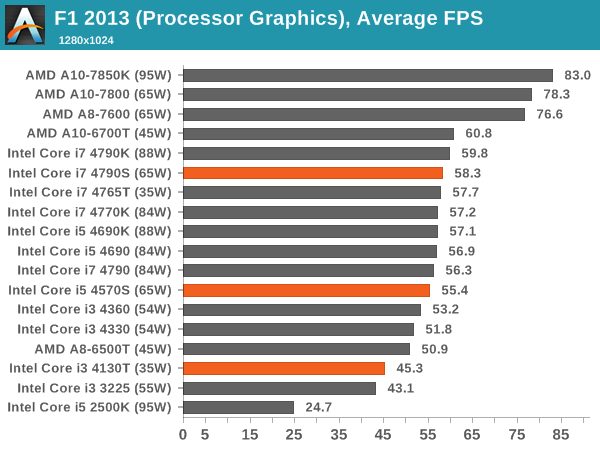

Bioshock Infinite
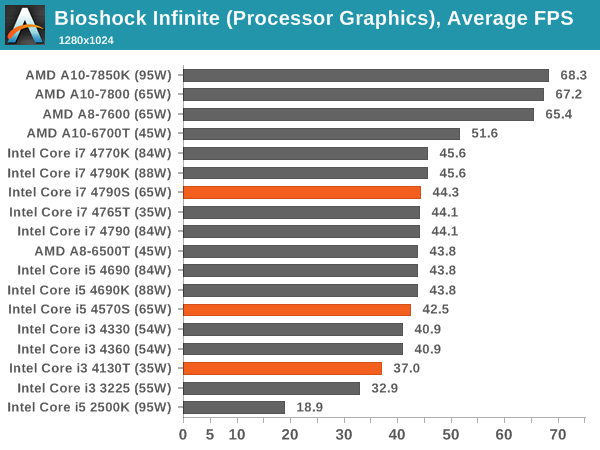
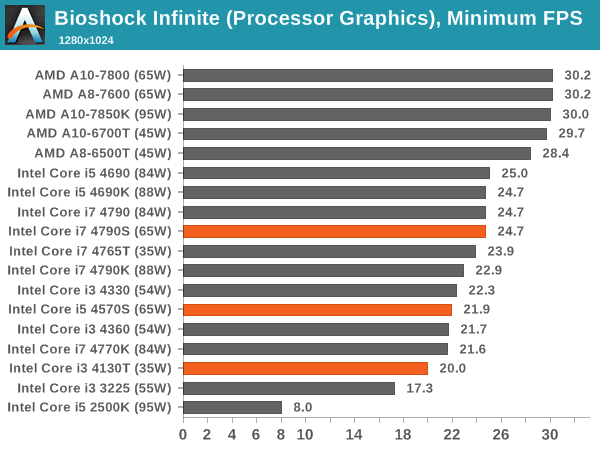
Tomb Raider
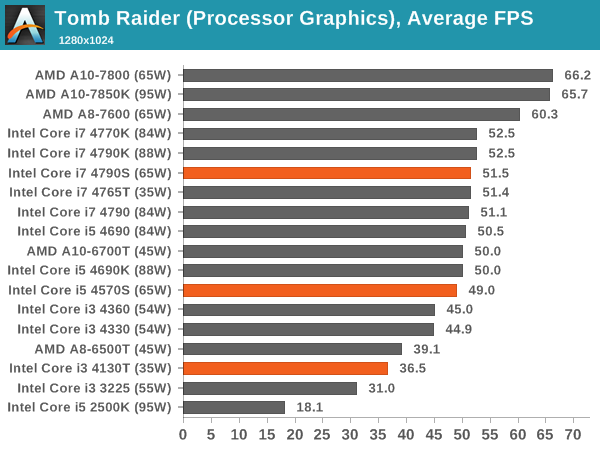
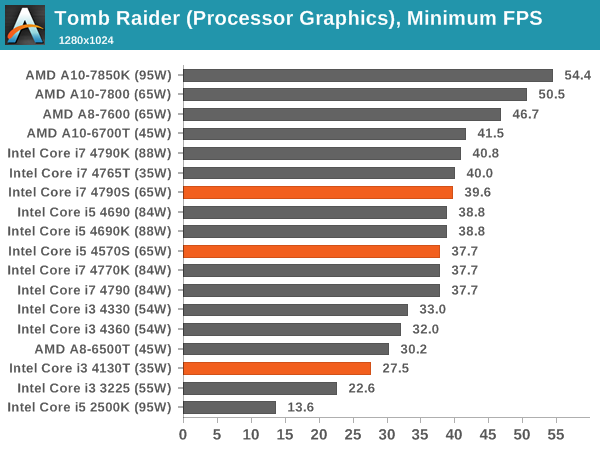
Sleeping Dogs
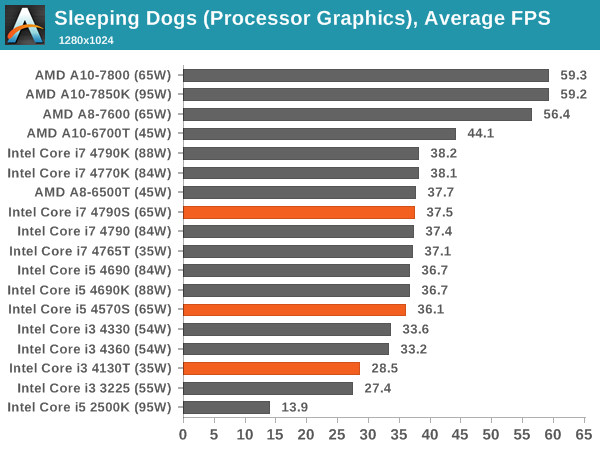
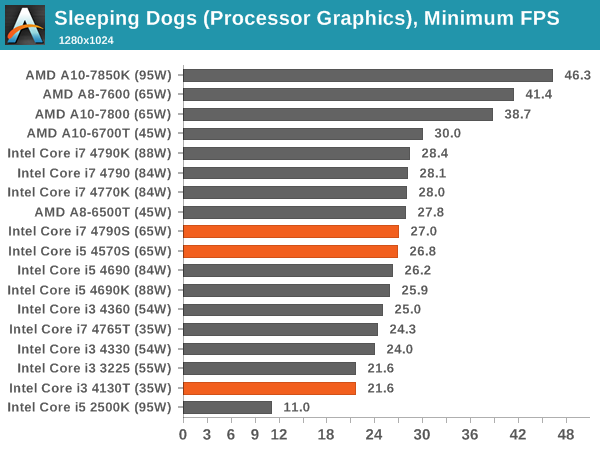
3DMark FireStrike















76 Comments
View All Comments
MrSpadge - Thursday, December 11, 2014 - link
> lower power cpus, saves us time from undervolting and just draws less power from day one.That's not the same. Low power CPUs limit your clock sped when you need it most, i.e. under full load. Whereas undervolting delivers full performance, or in TDP limited cases even higher performance. It does cut into the OC headroom, though.
xeizo - Thursday, December 11, 2014 - link
I expressed it badly, sorry. The point is as these cpus are TDP-limited you know how much they will draw the most, and can design cooling/case etc. based on that, and in "99%" of home user cases you don't need the extra performance of 4xfull load+OC without restraints - the cpu is fast during "normal" use. Even gaming. It's not the best buy for a pure rendering box or similar though ...xeizo - Thursday, December 11, 2014 - link
Btw, I noticed at a customer they had replaced all the workstations with mini-ITX HP:s, running 4570S and having SSD:s. They felt very snappy.azazel1024 - Thursday, December 11, 2014 - link
It would be nice to see what the idle power consumption is with like setups on some of the processors. In addition it is a shame that you have dV for power consumption for the Pentium models...but there are NO performance benchmarks for them. Both of the Haswell pentiums have roughly the same power consumption of the i3-4130t, but no idea what they actually can put up in terms of performance. Also rather suprised that the older Ivy Bridge i3 has such low power consumption, but seems to average slightly better than the i3-4130t.Too bad no test of the 4MB cache and higher clocked Hasy i3-ts. That would have been interesting, as that is almost exactly what I am thinking of replacing my G1610 server with. Though realistically by the time I get around to it, I'll probably be looking at a Broadwell based server.
piasabird - Thursday, December 11, 2014 - link
A lot of the 35 watt i3 CPU's are not available for sale anywhere. Especially the Haswell with the 4 meg cache and the 4600 graphics. One question I would pose is cant you just buy a regular i3 and just underclock it to use less power?MrSpadge - Thursday, December 11, 2014 - link
Yes. XBitLabs tested exactly that and the result is the same as the S/T models. The automatic voltage-frequency scaling of Turbo does all the magic behind the scenes (i.e. lowers the voltage when you lower the clock).sireangelus - Thursday, December 11, 2014 - link
Could we have mixed amd/intel linux test? it's very interesting to see since the compilers optimize more fairly.XZerg - Thursday, December 11, 2014 - link
Ian, man - seriously you need to stop these retarded Delta charts! They are useless! To make these even worse is that you are testing low wattage cpus. the people interested in such cpus are usually interested in idle and load numbers separately. what you have has no reference point to workout either the idle or load numbers.quit with these useless charts. there are many who have agreed to this.
sweetie peach - Thursday, December 11, 2014 - link
Agreed. Also the idle and load voltages would have been helpful.BrokenCrayons - Thursday, December 11, 2014 - link
I like the review, but I agree with this. I think readers would understand that their individual results are going to be different because they won't be running identical configurations, but we can do the simple subtraction ourselves if we want to see the difference in load versus idle. I'd much prefer getting the total system wattage at idle and load from a review. It seems more useful to me to see those raw numbers actually posted.